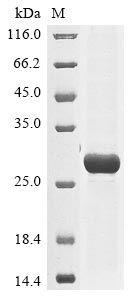Recombinant Human herpesvirus 6A Envelope glycoprotein B (gB) gets produced in an E. coli expression system and spans amino acids 23-188. The partial protein carries an N-terminal 10xHis-tag plus a C-terminal Myc-tag, which helps with purification and detection. SDS-PAGE analysis confirms purity levels above 85%, suggesting reliable performance in experimental work.
Envelope glycoprotein B (gB) from Human herpesvirus 6A appears to play a crucial role in how the virus infects host cells. It mainly contributes to viral entry by promoting membrane fusion. This protein sits within the viral envelope and represents a key target for researchers trying to understand viral pathogenesis and immune response interactions. That makes it potentially valuable for virology studies.
Potential Applications
Note: The applications listed below are based on what we know about this protein's biological functions, published research, and experience from experts in the field. However, we haven't fully tested all of these applications ourselves yet. We'd recommend running some preliminary tests first to make sure they work for your specific research goals.
Glycoprotein B (gB) is a highly glycosylated viral envelope protein that normally folds in the endoplasmic reticulum and undergoes extensive post-translational modifications, including N-linked glycosylation and disulfide bond formation. These modifications are critical for its correct tertiary structure, trimerization, and biological activity, particularly for mediating viral fusion and host receptor binding. Because E. coli lacks the glycosylation and oxidative folding machinery required for proper gB maturation, the recombinant fragment (23–188aa) is very unlikely to be correctly folded or biologically active. It most likely exists as a denatured or partially refolded polypeptide. However, the linear amino acid sequence remains intact, meaning it can still expose linear epitopes and is therefore useful for immunization or antibody-based assays, but not for functional receptor-binding or structural studies requiring native conformation.
1. Antibody Development and Characterization
This recombinant HHV-6A gB fragment (aa 23–188) can serve as an effective immunogen for generating antibodies against the envelope glycoprotein B of HHV-6A. While expressed in E. coli and thus likely non-glycosylated and misfolded, the protein retains linear epitopes suitable for antibody generation and screening in ELISA or Western blot assays. Researchers should note that antibodies raised against this fragment will likely recognize denatured gB rather than its native conformation, and further validation using full-length, glycosylated gB is required to confirm specificity for the native viral protein.
2. ELISA-Based Binding Assays
The recombinant gB (23–188aa) fragment can be used as a capture antigen in ELISA formats for detecting anti-gB antibodies or for serological assay development, given its intact linear sequence. However, it should not be used to study gB-receptor or gB-glycoprotein interactions, as those rely on native conformation and glycosylation, which are absent in this bacterial expression product.
3. Structural and Biochemical Characterization
This fragment may be used for basic biophysical assays (e.g., SDS-PAGE, CD spectroscopy) to assess purity, solubility, or aggregation state, but it cannot provide physiologically relevant structural data. The absence of glycosylation and native folding disqualifies it from structural studies aiming to elucidate gB domain architecture or fusion mechanism. It is best suited for low-resolution folding or stability comparisons under different refolding conditions.
Final Recommendation & Action Plan
The E. coli-expressed HHV-6A gB fragment (23–188aa) is not correctly folded or biologically active due to the absence of eukaryotic glycosylation and disulfide bond formation. While unsuitable for functional interaction or structural analyses, it remains useful as an antigen for antibody development, ELISA-based detection, or preliminary epitope mapping targeting linear peptide sequences. Avoid using it in receptor-binding or viral entry mechanism studies.






